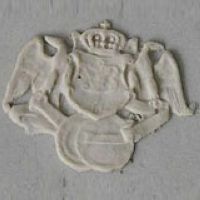
Image 010801-02-01
Used between 1842 and 1860.
During 1748 the respected iron founder François Boch began manufacturing ceramic tableware in the village of Audun-le-Tiche in the Duchy of Lorraine. His plates, cups, pots and tureens had simple shapes but were of excellent quality and because of this his goods became well known in a relatively short period of time. Based on his success he founded the company of Jean-François Boch et Frères with his brothers during 1767; this second factory was located in Septfontaines (Seven Springs) not far from the Luxemburg fortress and commenced in early industrial serial production.
Already in 1770 the Septfontaines factory started to produce goods with the famous "Brindille" pattern which is still in the Villeroy & Boch product range today under the name of "Alt-Luxemburg". Of course, other businessmen tried to copy the success of François Boch and one of them was Nicolas Villeroy who set up an earthenware factory in Vaudrevange (today called Wallerfangen) on the River Saar in the year 1789. He successfully applied decorations onto tableware by using the advanced copper plate printing technique which was a decisive precondition for cost-effective serial production.
In 1809 Boch bought the former Benedictine abbey in Mettlach on the River Saar where he set up a very modern and extensively mechanised system for tableware production. In fact many of the machines were designed by Boch himself and his inventions started a new era as manual ceramic manufacture was now to be replaced by industrial production. Today, the baroque building is still the corporate headquarters of Villeroy & Boch. But technical advances were not the only speciality of the family and Pierre Joseph Boch who had been introduced to the trade by his brother greatly improved the social security system for their workers by founding the Antonius Guild in Septfontaines during the year 1812.
That system even exceeded the benefits introduced 70 years later in the often praised social security system founded by the German leader Bismarck. As can be seen by now the Boch family was always interested in new ideas and during 1829 a new type of earthenware was developed at the Boch factory in Mettlach. This new material was of a bright white color and extremely stable, thus strongly representing porcelain and therefore called 'porcelain stoneware'. The secret of its manufacture was kept well inside the company walls so that no competitor was in the position to produce anything like it.
In order to survive on the European market the two former rivals Jean-François Boch and Nicolas Villeroy decided to merge their three factories to form one business enterprise. In 1836 the Villeroy & Boch company was founded and soon started its advance on European market leadership, especially after the marriage of the Villeroy and Boch children in 1842 that bonded both families together even further. The company started to greatly expand its product range in 1843 and one of the first larger investments was the founding of the Cristallerie glassworks in Wadgassen, a factory that still supplies products complementing the tableware range up until today.
From 1846 onwards Villeroy & Boch supplied tableware and decorative objects to all areas of Germany and that success was soon followed by a revolutionary new process in tile manufacture. The invention of dry compression moulding in Septfontaines was not only a milestone in company history, it greatly influenced the whole industry and in principle, tiles all over the world are still made in the same way even today. By the year 1850, full range production of high-quality bone china and marble-like parian earthenware had been established, followed by multi-colour pattern printing for decoration purposes; the company now not only supplied all European markets but had also managed to find its place on the North and South American market.
Another important step in the company history was the introduction of newly-developed floor tiles during 1852 which were particularly attractive and hard-wearing, resulting in the so-called "Mettlacher Platten" becoming incredibly successful throughout the world. Demand was so great that the Mettlach factory actually became the first European factory specialised in tile manufacture alone. But the factory also had to cope with personal setbacks: the year 1858 saw the death of Franz Boch-Buschmann, the loved and admired founder of the faiencerie in Mettlach.
Still needing to expand, the company took over a factory in Merzig on the River Saar during 1879 and next to the normal tiles that factory also produced terracotta items that were used in the upcoming new area of business of architecturally applied ceramics. Both production lines were an immense success and the factory in Merzig soon evolved into the largest manufacturer of floor tiles and terracotta anywhere in the world.
Highly specialized factories proved extremely promising and around 1882 the main focus of the Mettlach factory was the production of washing vessels which were used by people from all walks of life. Production of normal earthenware and majolica items was distributed to other factories, for example the Villeroy & Boch, Niederlassung Schramberg, which existed between 1883 and 1912; gradually however all basins and jugs were pushed aside to make room for ceramic sanitary ware as we know it today.
Eugen Boch (born 1809), founder of the mosaic factory in Mettlach, was in 1892 decorated for his work for the whole ceramics industry and his efforts in providing and supporting welfare institutions for workers and their families. He was made Privy Councilor of Commerce and raised to peerage, allowing him to carry the name Eugen von Boch; he died in 1898.
In 1899 the large-scale production of ceramic sanitary ware like bathtubs, sinks and WCs in a new type of material similar to pipe-clay started at the works in Merzig and shortly afterwards, the revolutionary slip-casting process followed, drastically reducing production costs and making bathroom equipment affordable for everyone.
Following the separation of the Saar region from the German Reich in 1920 as a result of First World War, the factories located there were no longer available and Villeroy & Boch compensated this by acquiring factories like the Steingutfabrik und Kunsttöpferei Franz Anton Mehlem in Bonn as well as the Mosaikfabrik Deutsch-Lissa near Breslau (1920-1945) which was later followed by the Steingutfabrik Torgau (1926-1945). It should be noted that between 1923 and 1935, the factories located in Germany were grouped as a limited corporation with its main office in the city of Dresden.
As always, Villeroy & Boch showed perfect timing and the success achieved was quite impressive even when compared with todays standards. Always on the lookout for new inspiration, revolutionary new ideas like that of the Bauhaus movement were taken up by Villeroy & Boch during 1930 and the style reflected in the entire product range. At that time, Villeroy & Boch employed around 10,000 people but the Recession took its toll and by 1931 the factory in Bonn and the Steingutfabrik Wallerfangen (1790-1931) had to be closed. After 1935, the limited corporation was dissolved and all factories were treated as single firms with a general office in Mettlach.
During the Second World War the factories in all parts of Germany were considerably damaged and after the war the works in 'Deutsch-Lissa' near Breslau as well as the factories in Dresden and Torgau were expropriated; the works in the Saar Basin were integrated into the French economic area. Once again, the company had lost great parts of its production capacity, but this dark period in company history did not last for long. Concentrating on basic designs and supplying the market with sanitary items and tiles during the post-war years, Villeroy & Boch was on its way to become a global enterprise. Slowly picking up speed, production of the new and particularly hard vitreous porcelain began at the Septfontaines factory in the year 1959 and after many hard years, the company finally advanced into areas never served before after selling the first ever large-scale shipment of tableware to Japan in 1971.
But Villeroy & Boch also continued to gain popularity in other overseas markets and particularly in the USA. In 1975 it was obvious that the significance of excellent designers creating everyday objects would increase and the company concentrated on producing outstanding designs. One of the boldest steps was to enlist the famous designer Luigi Colani who was to design a complete set of bathroom equipment. For Villeroy & Boch it was the beginning of a new way of thinking: instead of just selling single products they now produced whole 'living areas' based on the ideas of designers. But the company did not forget the customers who still wanted more settled designs and so Villeroy & Boch in 1976 purchased the traditional Heinrich porcelain factory in Selb for this purpose.
Following the gradual changes on the world market, the whole enterprise was re-structured during 1982 and the factories that had until now worked on a decentralised basis were recombined to form three main divisions: tiles, sanitary ware and tableware/crystal. This process of specialization was followed in 1986 by the acquisition of the Gallo Design dealer brand which expanded the range of well-laid tables in the direction of the younger customers; Paloma Picasso commenced her co-operation with Villeroy & Boch by developing tiles, tableware, cutlery and crystal collections.
In 1987 Villeroy & Boch was converted into a public limited company and later extended its product range in the direction of plastic bathtubs and shower trays by acquiring a 50 percent stake of the Dutch Ucosan company in 1989. In 1992, a majority interest in Alfðldi Porcelàngyàr, the largest Hungarian manufacturer of ceramic sanitary ware and second largest in the area of tile production followed. Villeroy & Boch acquired a majority share in the company Mondial SA, a leading manufacturer of ceramic sanitary ware and tiles in Romania during 1996. Over time some product ranges were also dropped, for example V&B in October 2004 sold the Boch Fréres segment (by then a tile wholesaler) to Point P., a member of the French Saint-Gobain-Group.
What started off as a small venture became one of the largest and most advanced multi-layer manufacturers worldwide, producing many different items right up to the literal kitchen sink.
While the "Old Waller" shape/form was produced by the subsidiary in Wallerfangen the "Old Abbey Ware" shape/form was produced by the factory in Mettlach and commonly issued with the decorations "Alpina", "Fleurs de Montclair" and "Fleurs des Champs".
Some V&B marks include the addition "Made in France-Saar Economic Union", an economic (and political) union which existed from 1947 to 1956 (in 1957 the Saar region voted to rejoin Germany).

Image 010801-02-01
Used between 1842 and 1860.
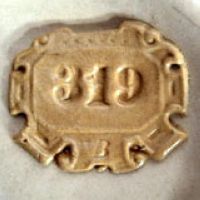
Image 010801-02-02
Used between 1852 and 1873.
(Picture by eBay user choral25)
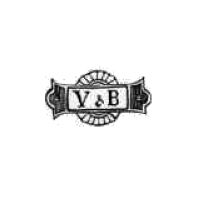
Image 010801-02-03
Used between 1873 and 1883.
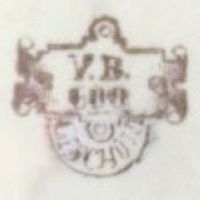
Image 010801-02-04
Used around 1888.
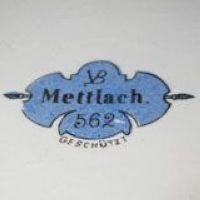
Image 010801-02-05
No dates known, appears to be an early mark.
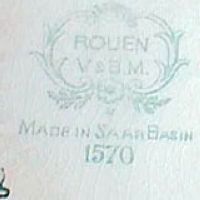
Image 010801-02-06
No dates known, appears to be an early mark (here on "Rouen" series).
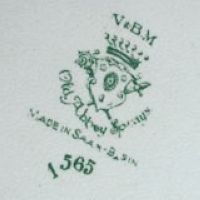
Image 010801-02-07
Used roughly between 1890 and 1920, series "Old Abbey Sprays", example with "V&B M" above the shield.
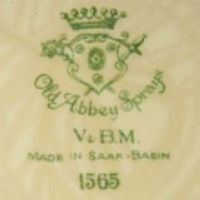
Image 010801-02-08
Used roughly between 1890 and 1920, series "Old Abbey Sprays", example with "V&B M" belov the shield.
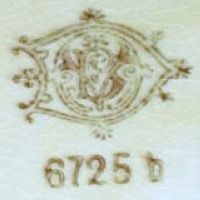
Image 010801-02-09
No date known, also an early mark.
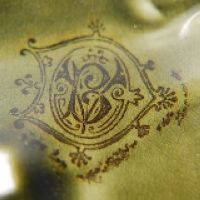
Image 010801-02-10
No date known, another example.
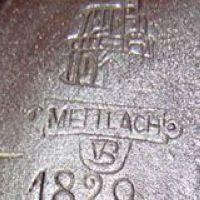
Image 010801-02-11
Used until around 1900, impressed version on a dark colored item.
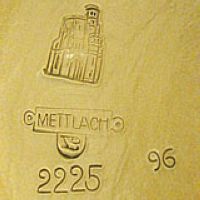
Image 010801-02-12
Used until around 1900, impressed version on a lighter colored item.
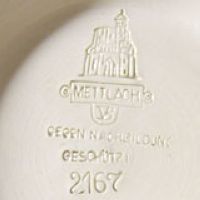
Image 010801-02-13
Used until around 1900, impressed version with "gegen Nachbildung geschützt" (design registered by an early form of copyright).
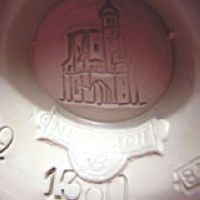
Image 010801-02-14
Used until around 1900, interesting version with "Mettlach" set alone.
(Picture by Dave O'Callaghan)
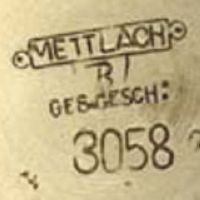
Image 010801-02-15
No date known, rare version without the abbey part, just ges. gesch. over the interlocking "VB".
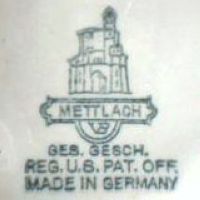
Image 010801-02-16
Used until around 1900, printed ink version with "ges. gesch." and "Reg. U.S. Pat.Off." indicating registration in Germany and the US.
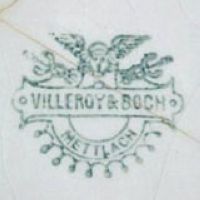
Image 010801-02-17
Used between 1874 and 1909, basic version.
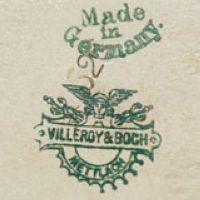
Image 010801-02-18
Used between 1874 and 1909, same as before but with offset "Made in Germany" addition.
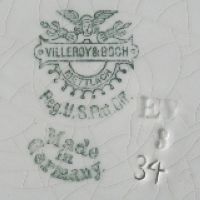
Image 010801-02-19
Used between 1874 and 1909, same as before plus "Reg. U.S. Pat.Off." addition.
(Picture by Eugene Huntjens)
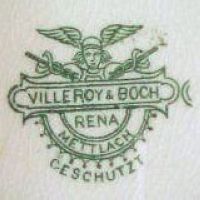
Image 010801-02-20
Used between 1874 and 1909, with "geschützt" (registered). "Rena" was the series.
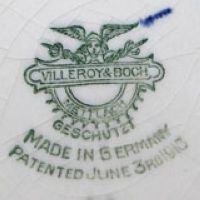
Image 010801-02-21
Normally only used between 1874 and 1909 but here with "geschützt", "Made in Germany" and "Patended June 3rd 1913".
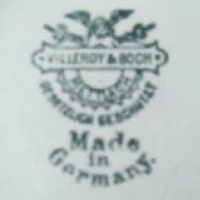
Image 010801-02-23
Used between 1874 and 1909, with gesetzlich geschützt and "Made in Germany" addition.
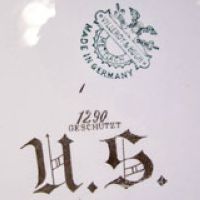
Image 010801-02-24
Used between 1874 and 1909, with "Made in Germany" but offset "geschützt".
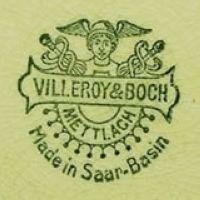
Image 010801-02-25
Used between 1918 and 1935, with "Made in Saar-Basin".
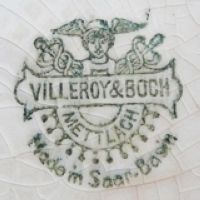
Image 010801-02-26
Used between 1918 and 1935, with "Made in Saar-Basin".
(Picture by Monika Birkl)
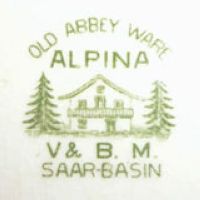
Image 010801-02-27
No date known, "Old Abbey Ware" (here a green version) is a V&B export trademark found on cheaper series.
(Picture by Susan Baldwin)
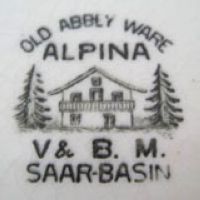
Image 010801-02-28
No date known, another "Old Abbey Ware" mark in black. In both cases "Alpina" is the decoration name.
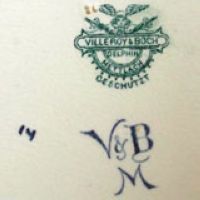
Image 010801-02-29
A mark combo: older green mark (used between 1874 and 1909) in addition with newer black one (used between 1893 and 1914).
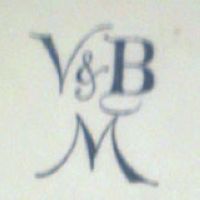
Image 010801-02-30
Used between 1893 and 1914, usually as standalone marking.
(Picture by John Shaddock)
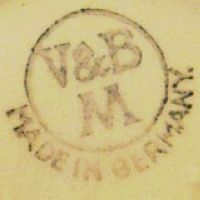
Image 010801-02-31
Used from 1913 until 1947, encircled "V&B" above "M" above "Made in Germany".
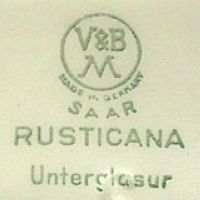
Image 010801-02-32
Used from 1913 until 1947, encircled "V&B" above "M" above "Made in Germany" and "Saar", here on a "Rusticana" item.
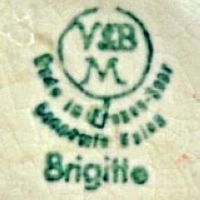
Image 010801-02-33
Same basic mark as before, but now above "Made In France-Saar Economic Union" and thus used between 1947 and 1956.
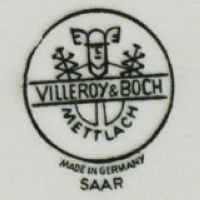
Image 010801-02-34
No date known, basic mark with "Made in Germany" and "Saar" additions.
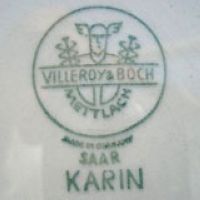
Image 010801-02-35
No date known, basic mark with "Made in Germany" and "Saar" additions as well as the design name "Karin".
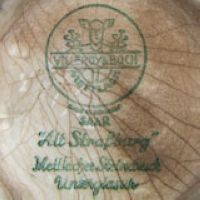
Image 010801-02-36
No date known, design "Alt StraßBurg" with "Mettlacher Steindruck Unterglasur" addition.
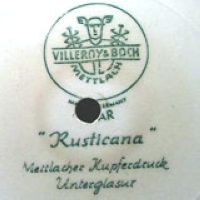
Image 010801-02-37
No date known, design "Rusticana" with "Mettlacher Kupferdruck Unterglasur" addition.
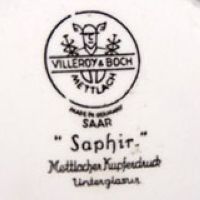
Image 010801-02-38
No date known, design "Saphir" with "Mettlacher Kupferdruck Unterglasur" addition.
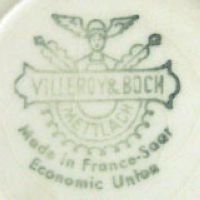
Image 010801-02-39
Used between 1947 and 1956, with addition "Made In France-Saar Economic Union".
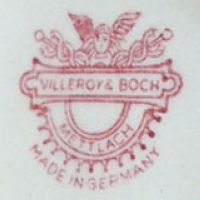
Image 010801-02-40
Used between 1874 and 1909, with "Made in Germany".
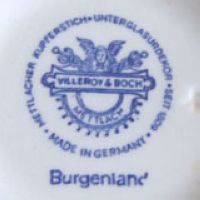
Image 010801-02-41
No date known, newer version in blue, here on a "Burgenland" item.
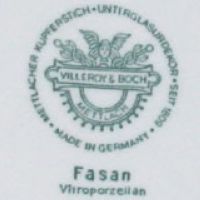
Image 010801-02-42
No date known, newer version in green, here on a "Fasan" (vitro-porcelain) item.
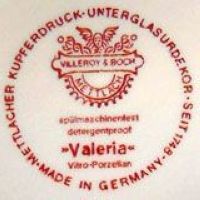
Image 010801-02-43
No date known, newer version in red, here on a "Valeria" (vitro-porcelain) item.
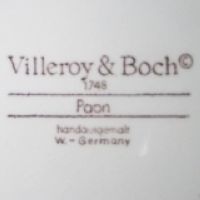
Image 010801-02-44
Used in the 1970's, here a version used on the "Paon" series (note the 'W.-Germany' used until 1990).
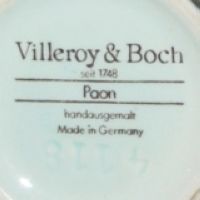
Image 010801-02-45
Here another a version used on the "Paon" series. Note the "Made in Germany" addition used after 1990.
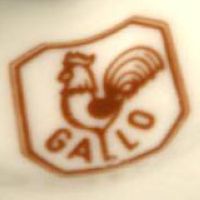
Image 010801-02-46
Since V&B acquired "Gallo Design" in 1986 *all* Gallo marks are incorrectly claimed to be V&B.
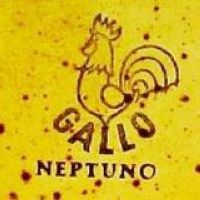
Image 010801-02-47
Since V&B acquired "Gallo Design" in 1986 *all* Gallo marks are incorrectly claimed to be V&B.
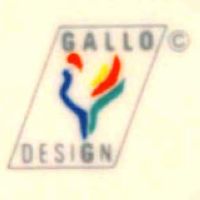
Image 010801-02-48
Since V&B acquired "Gallo Design" in 1986 *all* Gallo marks are incorrectly claimed to be V&B.
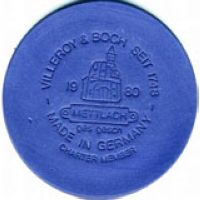
Image 010801-02-49
This mark is actually dated from 1980.
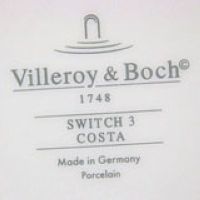
Image 010801-02-50
Recent mark on "Switch 3 / Costa".
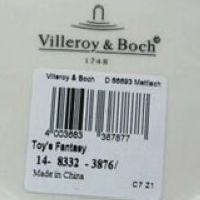
Image 010801-02-51
Recent mark with label showing "Made in China".
© 2004-2026 C.S.Marshall, all rights reserved